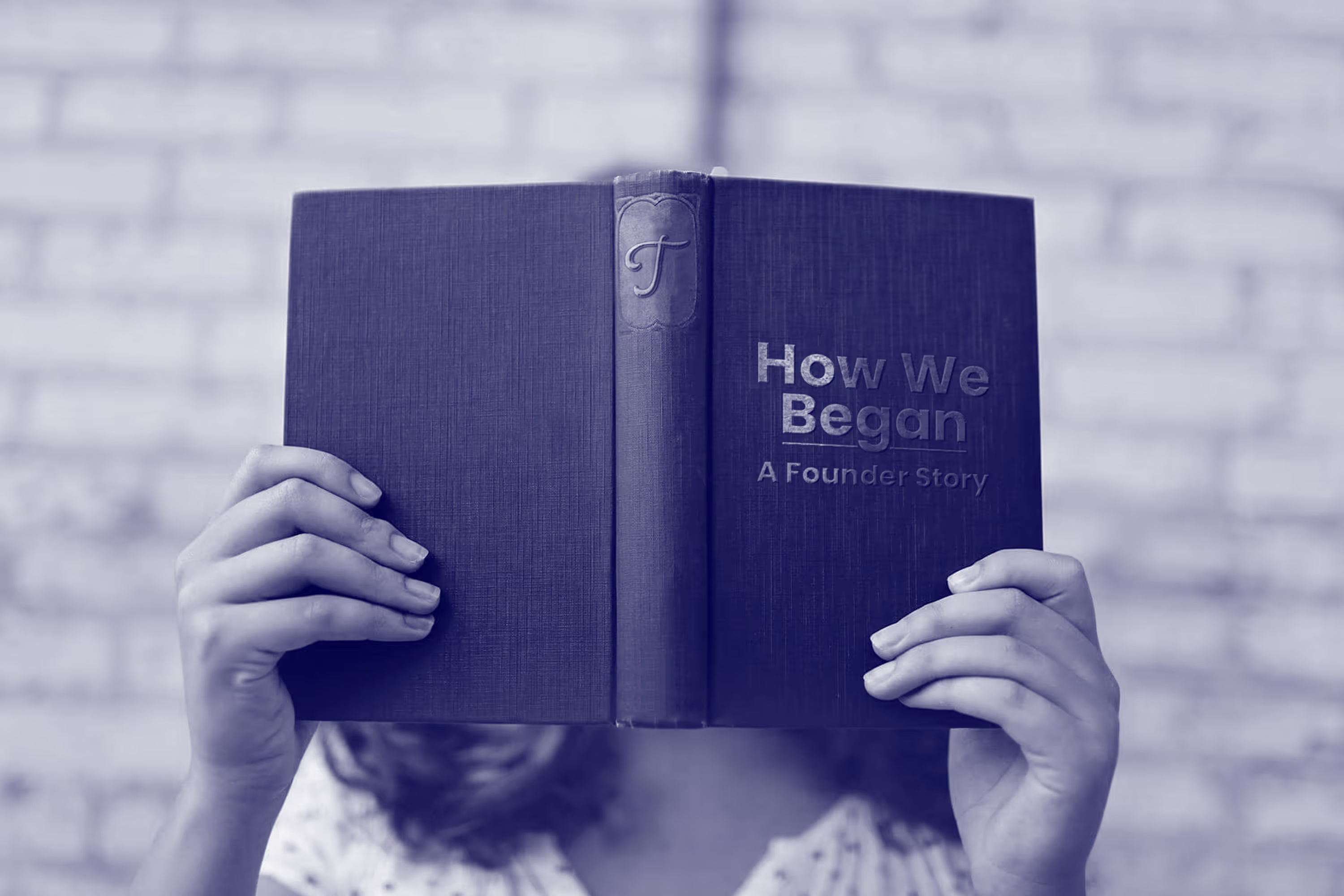
Articles
Founder Stories: Giving New Hires Their Company’s Origin Story
June 14, 2022

A proper onboarding experience is one of the best investments a startup can make. It ensures the success of its employees and, by extension, the success of the organization.
Part of that onboarding experience is sharing the company’s origin story (or, founder story) with new hires. And with good reason — a strong or compelling history can help set a company apart and help them attract and retain qualified talent.
But what is a founder story? Are they really that powerful? How do you go about sharing one? This guide aims to answer those questions. But first…
The power of a good (founder) story
A founder story describes how a business began and how it has evolved. Think of it as a superhero origin story — what set your intrepid hero on the path to business leadership?
No business has the same founder story — the journey from its inception to where it is today is unique to each organization. Sharing insight into the hopes, challenges, and growth that went into forming an organization gives businesses plenty of opportunities to connect with their new hires, clients, or customers. How, you might ask? To answer that, let’s jump right into the benefits of sharing your founder’s story.
The benefits of sharing your founder’s story — with new hires and your customers.
1. It helps employees feel that their role in the company is more than just a job.It leaves a good first impression.
.gif)
According to Cohesive, there are at least two archetypes when it comes to a founder story:
- David vs Goliath.
- The Quest.
The David vs Goliath archetype goes a little something like this: “David often spots an opportunity where big corporations are getting it wrong. They start businesses that aim to disrupt the status quo, to do things differently, and to make life better for people."
The Quest archetype, on the other hand, tells the story of perseverance when most others would lose faith: “They’re the businesses with the 30 failed prototypes that paved the way for the one successful one."
Think about the last time you read the “About” page of a company’s website. Perhaps you were looking for a connection between you and the business’ founder — their story, brand, and values.
The narrative you weave begins to shape how you interact with customers who enter your digital storefront. You have the opportunity to create an impression that makes your customers feel good or to have your company forgotten as soon as they click away.
2. It helps employees feel that their role in the company is more than just a job.
.gif)
A founder story lets candidates know that your company isn't just policies, job descriptions, and mission statements — it's a group of real people working together and relying on one another to get the job done.
An effective founder story can pique interest and engage candidates with your workplace culture even before the actual hire is made. The story you tell should make applicants feel empowered and honored to work for your organization and see it as more than just a source of income.
For instance, a founder story that describes the journey of the founder from humble beginnings is more likely to appeal to a lower- to a middle-class candidate. They’re more likely to connect with, and better yet even develop an emotional connection and sense of purpose to, your brand in a way that marketing alone might not be able to do.
3. It introduces a human element.
Ignoring the importance of a founder story is detrimental to a business. Not including one in your business’ storytelling is a missed opportunity. Whether it’s your customer or employees, a founder story inserts a human element into your business and tells these stakeholders that you see them as more than just a simple financial transaction.
In the case of customers, this human essence helps them connect with your business on a deeper level. This helps businesses cultivate trust which eventually leads to brand loyalty.
In the case of employees, humanizing your company helps kindle a sense of belonging. Engaged employees are more likely to be invested in your company’s accomplishments and work hard to achieve them!
According to Harvard Business Review, high belonging was linked to a whopping 56% increase in job performance, a 50% drop in turnover risk, and a 75% reduction in sick days. Employees with higher workplace belonging also showed a 167% increase in their employer promoter score (their willingness to recommend their company to others).
How to share your founder story with new hires
What’s your why?
Every story has a hero who overcomes adversity: Spider-Man. Frodo. Lara Croft.
Your founder story should be about you, your struggle, and how you solved it. Your company was founded with a purpose, and that purpose probably wasn’t focused solely on making money. Did you follow a calling to right a wrong, fill a gap, or be of greater service?
Going back to your roots is an excellent way to reveal what it was that drove you to start your business. The clearer you can articulate the background of your story, the easier it is for your listener to identify with you. Think back before you got your business up and running — what problem(s) did you face? What compelled you to come up with a solution?
.gif)
Telling your brand story can also shine a spotlight on the founder(s) in a strategic way — it can help craft an emotional connection with your audience from the start. Showcasing the founders, their vision, and their sheer will to solve a customer problem by starting a company puts a human face behind a corporate entity and makes your brand much more relatable.
Create a timeline.
With a timeline, you can record the who, what, when, where, and why of your company’s story. This includes who founded the company, their vision for it, the company’s values, and major milestones.
Your twists and turns make your story authentic, and add an element of suspense. And owning every success and hiccup of your company’s history helps build credibility with your audience and establishes you as the clear authority in the field — which can add value to your overall brand.
You can start by identifying mistakes, what you learned from them, strokes of luck, moments of doubt, leaps of faith you took, and other important milestones in your journey. You can go a step further and point out what milestones were instrumental to the success of your business today.
What do you want your audience to feel?
If it wasn’t for your customers, you’d be out of business. Your story should not only present the evolution of your company, but it should also make customers feel that they were part of that evolution. An excellent way to achieve this is to think about what emotions you want your audience to feel when they’re reading your story.
.gif)
What’s that one thing you want them to feel? Motivation? Inspiration? Connection?
Emotions create a bond between the story's hero and the audience while making the narrative more memorable. Letting your customers feel that they’re not just purchasing a product, but contributing to something big can ignite a cascade of emotions that’ll help you foster long-lasting relationships.
Creative ways to share your founder stories
Use websites and visual blogs.
In today’s digital age, the majority of customers visit a company’s website before making a purchase. Having an online presence has become an absolute necessity because it increases an organization’s credibility, showcases its brand, and keeps customers up-to-date on both the products/services and the company as a whole.
Your company’s website can be a great place to tell your founder story. Most businesses use a dedicated “About Us” page that focuses on highlighting the biggest selling points of your story and brand which can leave a strong first impression on curious customers.
You can go one step further and create a separate blog that tells your story to the world. According to 61% of B2B marketers, SEO and organic traffic generate more leads than any other marketing initiative — that means your blogging strategy must be at the top of its game. Strong, concise copywriting coupled with visual storytelling can do wonders for your business and help bring your story to life. You can also get creative with your efforts by using infographics and shareable social snippets.
Take advantage of Twitter threads.

You can also share your founder story in a Twitter thread or a series of connected tweets. Not only is this a fantastic ongoing resource, but once someone discovers one tweet in the thread, they’ll be connected to all of the other ones in the series.
The internet has created an overload of information and when people land on a story, they very rarely make it down the page most don’t even make it halfway. As a matter of fact, a stunning 55% spent fewer than 15 seconds actively on a page.
Therefore, a Twitter thread is a great way to churn out longer pieces of content over a series of bitesize snippets, which ensures that the audience takes enough time to read and grasp the information at their convenience.
Create video content.
Show, don’t tell.
Video content is a great way to use visuals and sound to convey the message you want to share rather than stating it outright. Visual and audio triggers play an influential role in how we feel, therefore video content is an excellent way to elicit emotion.
Our brains love stories. So much so, that when the right emotions are triggered, we tend to internalize them and make ourselves the central character. Eventually, we create an emotional bond with the storytellers. This is called neural coupling.
Take Casper for example. The direct-to-consumer mattress company has spent years studying the psychology of sleep and using it in its marketing efforts. If you head over to their YouTube channel, the narrator of the video uses ASMR-like tactics to evoke a sleepy, calm nature from the viewer.
Customers are more likely to experience these same feelings whenever they see the brand. The goal? Whenever you feel drowsy, you associate sleep with Casper.
Ready to inspire your new hires with your company’s origin story?
Humans have been telling stories for centuries, and they’re just as influential today as they were centuries ago.
Knowing the essentials of your company’s own story and being able to communicate it in a way that makes new hires feel like they can be part of its evolution are the keys to convincing great talent to join you in your mission.
You can start by putting your company’s journey into a historical timeline with Trainual. Not only will it codify your journey and give new hires a “bird’s eye” view of the company, but it can help orient them organically and authentically.
Incorporating your origin story into your company playbook can give your employees a strong sense of inclusion, knowing they are part of your company’s evolution as valued and appreciated team members.
Similar Blog Posts










